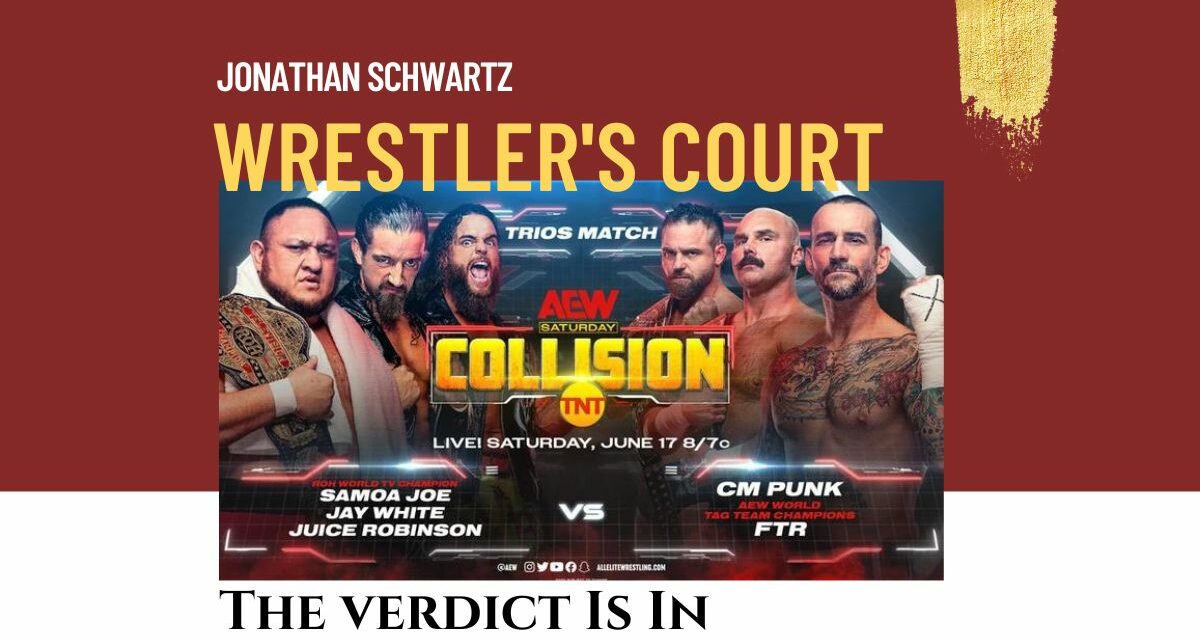I write this on the eve of June 17, when AEW will air the first episode of its new show, Collision. The show will air live on TNT, joining Dynamite and Rampage as part of AEW’s programming slate.
Collision has drawn interest from wrestling fans who have debated everything from whether it will lead to AEW’s own brand split, to whether AEW superstar and malcontent CM Punk will be part of the show (AEW boss Tony Khan spoiled that one on the May 31 edition of Dynamite, yes he will be), to AEW’s title card for the show, which borrows heavily from the old WCW Monday Nitro aesthetic. All this before the first episode airs.
In the spirit of the late King Kong Bundy, here’s a five count of things that I think Tony Khan and company can do to make sure Collision succeeds. Feel free to disagree. Khan ain’t paying me (yet).
1. KEEP THE BRAND WHOLE
If internet wrestling rumors are to be believed I’m likely already on the wrong side of history for this one. As soon as CM Punk’s name was floated as a mainstay for Collision rumors started to swirl about the possibility that the new show would lead to a brand split, with at least some talent being exclusive to each program. Fans suggested this was fallout from the ‘Brawl Out’ brouhaha which saw Punk and Ace Steel get into a physical altercation with Kenny Omega and the Young Bucks after Punk’s allegedly unscripted post-show tirade directed at the Elite, Adam Page and Colt Cabana.
Some fans have questioned whether Punk would ever come back. I always thought he would, since wrestling is known for bitter enemies working together for the sake of a payday. If Vince McMahon could welcome back the likes of Bruno Sammartino, Hulk Hogan, the Ultimate Warrior and Bret Hart, Punk isn’t much of a stretch. But I’ll get into Punk in more detail later.
My advice here is for AEW to resist the temptation to formally split its roster. At first blush, this seems like an easy way to deal with some challenging personnel issues, but it’s unnecessary. If hybrid work since the COVID pandemic has taught us anything, it’s that there are plenty of ways to avoid annoying coworkers when people don’t have to be on site every day. If wrestlers really don’t want to be in the same room, they can be booked on different shows on different days. AEW already staggers its use of talent and rotates wrestlers in and out of shows with months in between appearances. To build feuds or more complex storylines, they can pre-tape segments or promos or rely on the old trope that the wrestlers aren’t allowed to touch each other until storyline demands it.
Formally splitting the whole roster limits the number of competitive matches and begs the question about which prizes will be up for grabs when wrestlers fight. Elsewhere, this question has been answered by crowning new champions for each show. I think that approach devalues all belts since the biggest titles become glorified TV championships (with utmost respect to Arn Anderson). In AEW’s case, more titles would just be silly. I’ve written before about how there are too many belts floating around, especially for a promotion that runs a very limited live touring schedule. When most of AEW’s energy is directed to TV, it’s tough to find the functional difference between the World, International and TBS championships as it is.
Judiciously defended titles can make a broadcast more interesting. An alphabet soup of belts defended with little reason becomes repetitive, especially if we don’t have a reason to care about the belts or their holders. Remember how I mentioned Rampage is already less relevant than Dynamite? The June 2 edition featured four title matches, as follows:
- El hijo Del Vikingo vs. Komander vs. Dralistico for AAA Mega championship
- Shibata vs. Lee Moriarty for ROH Pure championship
- Willow Nightingale vs. Emi Sakura for NJPW Women’s Strong championship
- Zack Sabre Jr vs. Action Andretti for NJPW TV championship
On paper these look like very good matches even without the additional fake stakes. Add less-formally recognized titles like the FTW belt, the Owen Hart Cup (which is starting up again) and the Dynamite Diamond Ring, and another set of titles feels like participation trophies. AEW already has a second in-house brand, Ring of Honor, which has a full slate of champions who play subservient roles to AEW angles. But that’s a mess I’ll get into later.
At this stage in wrestling history, a brand split feels derivative and futile. WWE has gone back and forth on the subject for 20 years now and has yet to hit a consistent, believable formula. I’ve written before about the promise that comes with the WWE draft, and the disappointment caused by the utter lack of storyline logic or long-term planning that follows. Wrestlers are drafted individually, except when they’re not, which seems to be when they’re part of established tag teams or stables, except when they are. Other wrestlers are left as ‘free agents’ either because they’re in demand as main eventers (Brock Lesnar or John Cena), because they’re injured (Bray Wyatt, assuming he comes back), or because… well, I don’t know. Disinterest? (Baron Corbin, Dolph Ziggler, Mustafa Ali.) Even then, the rosters are flexible; nothing really prevents talent from migrating between Raw and SmackDown. AJ Styles — a SmackDown wrestler — lost to Seth Rollins in the World Championship finals; then, per Vince McMahon’s edict, teamed with Rollins on the next Raw. Baron Corbin and Mustafa Ali popped up on NXT. Every so often the split collapses in its entirety, leaving us wondering about the point of the exercise and turning the championship scene into a mass of asterisks.
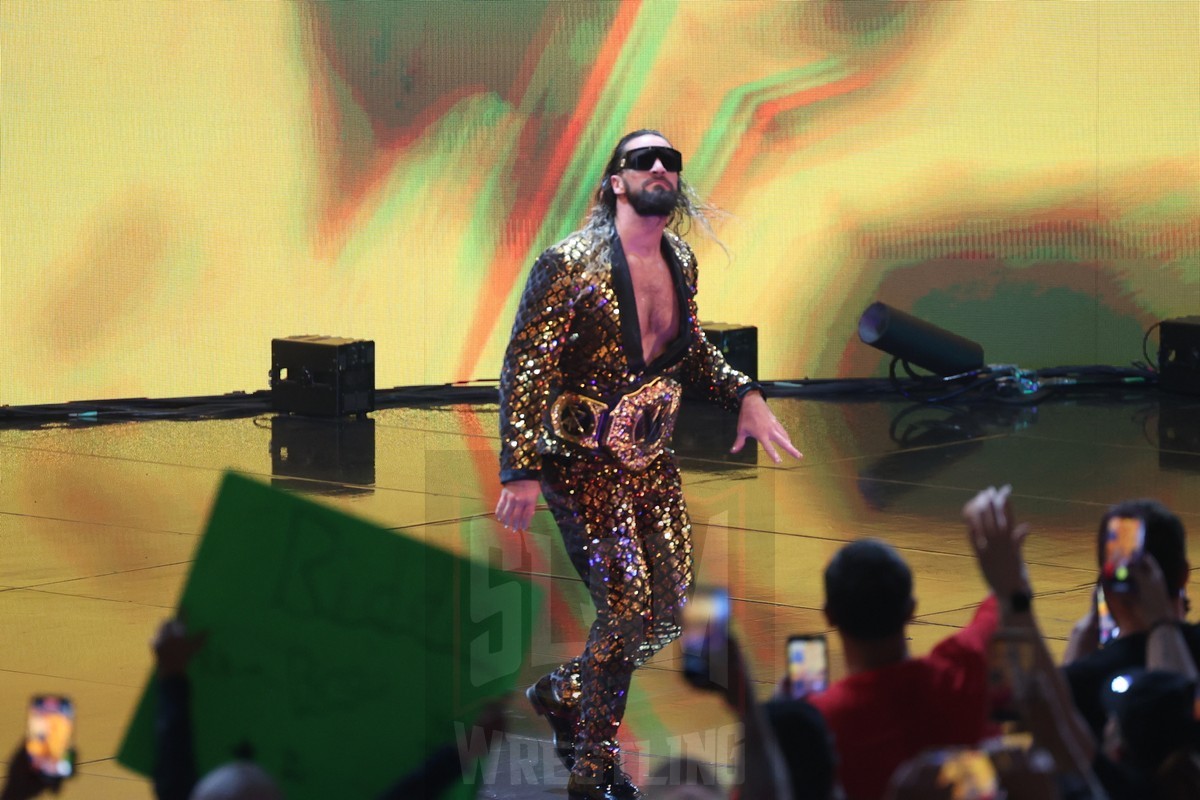
Seth Rollins starts off WWE Monday Night Raw, at XL Center, in Hartford, CT, on Monday, June 5, 2023. Photo by George Tahinos, https://georgetahinos.smugmug.com
As recently as last year, WWE booked itself into a brand-split corner by having Roman Reigns unify the WWE and Universal titles, only to defend them rarely. Reigns’ reign left RAW without a championship presence for over a year. In the absence of a fighting World Champion WWE has tried to elevate secondary belts like the Intercontinental or US titles and to give the women’s division a bigger showcase. Years of inattention have made all of these belts also-rans. WWE’s latest solution is to leave Reigns with his two belts (although they may soon be smelted into one) and bring back the “World” championship that was first gifted to Triple H by Eric Bischoff well before Luchasaurus roamed the Earth. Handing the belt to Seth Rollins as a workhorse champ may be a smart move, but it’s clear that this title is as much a consolation prize today as it was when Brock Lesnar took the original WWE title to SmackDown back when Paul Heyman had a ponytail.
So leave the roster whole; give fans the best matches on a given show. Be a little thoughtful when drawing up the evening’s booking sheet if it’s too much to ask professional wrestlers to be professional. Keep titles in play within the AEW universe unless there’s a good reason not to (OK, I have one reason set out below).
2. BRING BACK CM PUNK — SPARINGLY
Since he signed with AEW following seven years of pro wrestling inactivity, CM Punk has dominated wrestling fans’ discourse. We were excited, if wary, about Punk’s return and through his first run and recent absence have spilled a Jon Moxley segment’s worth of ink dissecting his every move.
Much of the discussion has focused on just when Punk’s relationship with AEW would sour, how it would happen and whether Punk has mellowed enough for there to be something to salvage. Apart from his conduct at last year’s All Out, Punk needed time to heal from a series of injuries (some of which were caused in the backstage fight he allegedly started). Lawyers may have been involved in bringing the various parties back together. Enmity may remain between Punk and the other brawlers. It’s understandable that the creation of a new show, which would require established headlining talent, would become a focal point for the latest CM Punk will-he-or-won’t-he rumors. As noted above, Tony Khan’s recent Special Announcement made clear that Punk will return. However, Tony was more circumspect about the role that Punk will play.
I’m a CM Punk fan. I enjoy his matches and when he’s on I think he’s an all-time great promo. David Shoemaker of the Masked Man podcast and blog went so far as to position Punk as a key player in what he called the “Reality Era” of wrestling. I agree. Punk’s misanthropy is well-known, and his antics have turned off a lot of fans. Personally, I dig it. Even as a good guy Punk gives off bad vibes, and his failure to play well with others speaks to my disaffection as part of Generation X. Really, what do we expect from a guy who sells a T-shirt in which he calls himself a “sociopathic, straight edge, atheist jerk”? You and me both.
I understand that in Punk’s prime he could be difficult to work with, and that the CM Punk hired by AEW had passed that prime. When Collision airs Punk will be 44 years old. He will have been out of wrestling for almost a year, on top of his earlier hiatus after leaving WWE. He’s been injured more than once, and his attempts to make it in UFC exposed him as a very good pro wrestler but not a legitimate fighter. His conduct following All Out may make other wrestlers hesitant to work with him and may make AEW and TNT executives worried about factoring him into long term plans, especially where a live microphone is involved.
On the other hand, Punk is one of a few wrestlers who can generate interest even when he’s not around. For years after his departure, Punk was an avatar for fans’ disapproval of WWE storylines. They’d chant for him at arenas around Canada and the US, particularly in Chicago. His name was the first one we thought of any time a surprise debut or return was promised, in companies across the US. When AEW started it seemed like a matter of time before Punk came back. Having returned and left again his name has never left the dirt sheets.
Punk has experience carrying feuds single-handedly. I always thought he caught the short end of the stick in his WrestleMania program against The Undertaker. Punk was ’Taker’s last opponent before Brock Lesnar broke Undertaker’s undefeated WrestleMania streak. Punk was also the first opponent to advance his program with minimal help from the Dead Man, who had severely restricted his appearances in order to extend his career. Punk would repeatedly call out The Undertaker, going so far as to leverage manager Paul Bearer’s recent death to build heat for a match whose result was a foregone conclusion. By the standards of previous Streak victims, Punk never had a shot, and Undertaker’s absence reinforced that point.
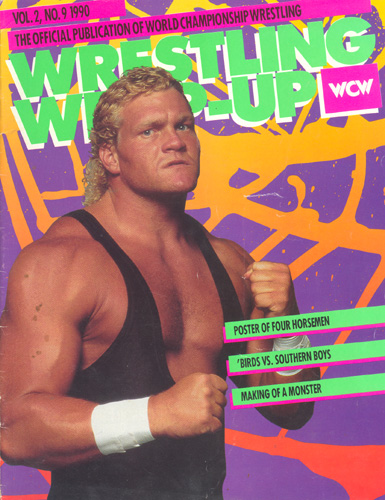
Sid Vicious.
Fortunately, there’s a template for how to move forward with Punk. Bruce Prichard set it out in an episode of Something to Wrestle With when describing the WWF’s relationship with Sid (Justice) Vicious. Like Punk, Sid was seen as a potentially huge draw. He had a great look, could cut a weirdly compelling promo, and had a strange charisma that drew fans to watch him fight. He was also openly disinterested in wrestling apart from the money, prone to injury and valued his time away from the ring in a way that limited long-term booking options (unlike Punk, who seems to genuinely care about wrestling, but is focused on his vision to the antagonism of others). Sid was also known to get into fights backstage, and his exploits with squeegees and scissors were hardcore before hardcore was cool.
Prichard and the WWF hired Sid on more than one occasion. After being burned the first time they learned how to use what they had: Sid would be booked into short programs on an abbreviated touring schedule, understanding that he was liable to no-show and another talent would have to be elevated to keep audiences happy. Sid got a pair of short WWF championship runs, even though he and the WWF always had an eye on the exit. He sold tickets, and when he was done, he was done. The WWF grew to accept this and took advantage of these short runs to help make newer bigger stars.
Sid’s booking is the blueprint for any number of WWE legend victory tours which have followed. Goldberg, Batista, Edge and others now get their swan songs, working shorter programs with an emphasis on TV and pay per views and few bumps against more athletic opponents who can flop around for them. WWE has started changing its approach to booking established stars like Randy Orton or Roman Reigns, who work more limited dates while being members of the active roster; saving time on their ‘bump cards’ for meaningful matches instead of smaller house shows.
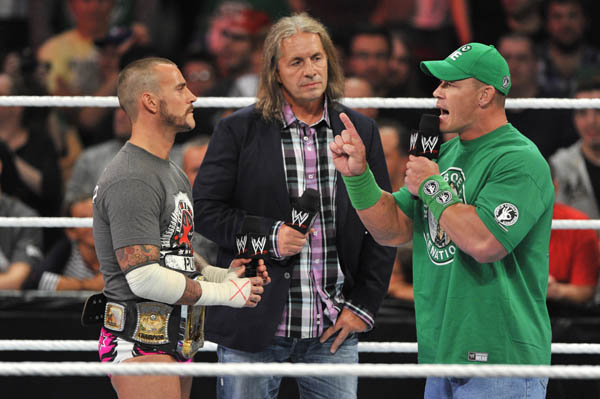
Bret Hart, with CM Punk and John Cena in the Bell Centre in Montreal in September 2012. Photo by Minas Panagiotakis
This approach might work well for Punk, even if as rumored he’s in line for a significant role backstage. We were all happy when he first came back but watching Punk work on a weekly basis dried up the nostalgia and laid bare how time and injuries had affected his in-ring performance. Punk can still talk better than most, but AEW has plenty of good monologuists. His feud against MJF worked because MJF could hang with him on the microphone and gave freely during their matches. It also helped that both men bled profusely in the kind of worked shoot performance where they excel. Give me a slow built feud like that leading to a couple of CM Punk matches a year and I’ll be happy. Even better if the matches air on Collision as extra special attractions.
Punk doesn’t need to wrestle every week to get over at this stage of his career, and beating the likes of Dustin Rhodes, Dax Harwood, Lee Moriarty or Pentagon Jr. don’t add to his legacy or build them up as contenders. If Punk is going to be part of Collision’s brand, he should be used more like Sting — brought in every so often to ignite the crowd, and in matches that reduce the risk of exposure or injury. Especially if, as initial audience reaction to his return suggests, he may be primed for an epic heel run.
3. TAKE CREATIVE RISKS
In my last column, I argued that Collision’s broadcast date and time are rooted in pro wrestling traditions. I love Saturday night wrestling and history suggests I’m not alone. I also acknowledge that airing a pro wrestling program on Saturday nights these days gives AEW a chance to connect with different demographics, although its position in what is currently seen as a ‘death slot’ means that the overall audience is smaller.
I’m guessing that audience will skew away from the 18-35 year old males who have been the focus of wrestling companies’ competition since the Monday Night Wars (and who hopefully have other stuff to do on Saturday nights) and towards younger and older viewers whose idea of a fun weekend includes staying up to watch wrestling. I think this could be a great thing. Chasing after a specific demographic can be limiting. A program that starts off as cool to an 18 year old becomes uncool once a 15 or 12 year old takes interest. ‘Adult’ storylines that appeal to high school or college students may be impenetrable to kids, or hard stops for parents who don’t think Katie Vick or HLA are appropriate for middle-schoolers. Eventually the desired 18-35 year old cohort ages out of the demographic, and without aging programming along with them (and really, who wants to watch Wrestling Matlock) or offering more family-friendly fare to capture the next cohort, wrestling companies set themselves up for hard times until the next pop culture moment.
It’s tempting to dismiss Collision out of hand given the smaller base audience, but appealing to fewer, potentially more engaged fans earlier in their journeys could work out. AEW has a chance to be a John Tenta-sized fish in a Shark Boy-sized media pond.
Fewer overall eyes on the product means less risk and lower expectations for TNT as AEW’s network home. Collision is primed to take advantage of wrestling’s historical position as cheaply produced TV content. Freed from a strongly competitive timeslot and with less pressure imposed by network executives, Standards and Practices and advertisers, AEW may have license to experiment with its format and content, as ECW and even WWF’s Shotgun Saturday Night before them.
ECW’s example is instructive. Paul Heyman saw his flagship program as wrestling’s version of the movie Pulp Fiction (so much so that he frequently used Dick Dale’s “Misirilou” over a closing montage of action, royalties be damned). It was a disorienting, raunchy, violent thrill ride that rarely used the same format two weeks in a row. Sometimes you got short clips from live events. Sometimes over the top promos from the likes of Raven, Shane Douglas or Heyman himself. Sometimes long-form hardcore or lucha matches, and once an hour long technical masterpiece between the late Eddie Guerrero and Dean Malenko, which has since been credited with changing American audience’s view of pro wrestling. Plus about a million Tajiri vs. Super Crazy vs. Little Guido matches, if that was your thing.
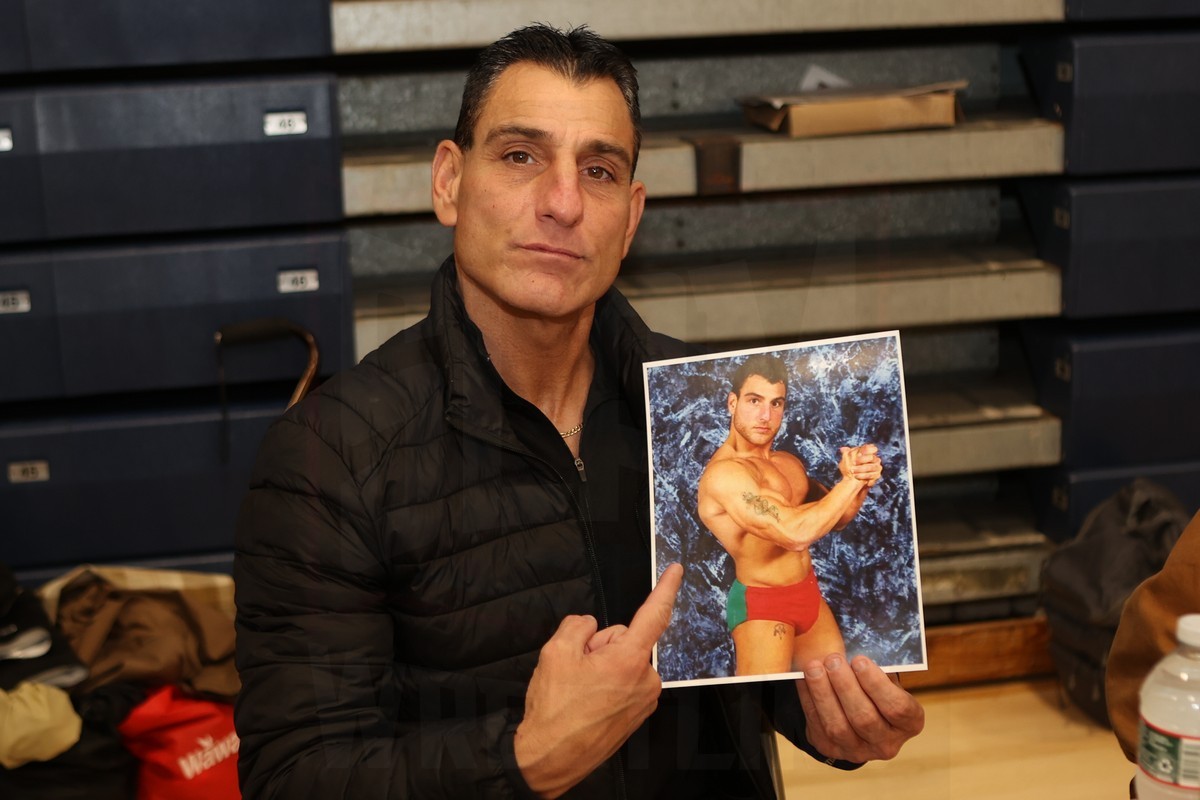
Little Guido at the Contest of Champions: Where Heroes Gather fan fest, on Saturday, December 3, 2022, at RWJBarnabas Health Arena, in Toms River, NJ. Photo by George Tahinos, https://georgetahinos.smugmug.com
Collision’s earlier timeslot augurs against the sex and violence and in favor of a more family-friendly program, but a touch of unpredictability would be great. One of the biggest complaints about current wrestling is just how formulaic it is. Matches are constrained to specific timeframes, promos are scripted and sanitized, and the humor that should come from an art form as absurd as wrestling is largely replaced by potty jokes. If you’ve watched for any length of time you can call out the beats of a match before they happen. If you know who’ll be on the next pay per view, you can figure out winners and losers as they approach the ring. Collision has a chance to become its own universe, to subvert audience expectations and provide the novelty that fans always crave. I would welcome a return to the long-form matches I enjoyed on ECW TV. AEW has no lack of talent that could pull these matches off, and who are likely dying to the chance to tear the house down like they do on the indies.
A smaller, less jaded audience might be more receptive as newer stars become more comfortable delivering promos, and if a failsafe is needed post-COVID we all ‘get’ how compelling a more cinematic presentation can be. Heyman’s program was always at the mercy of which stations would carry it in syndication. AEW has a network home and with it, a years-long commitment. Think of the possibilities for long-term storylines, especially involving those lower on the card, who rarely break through on flagship broadcasts. And if this all happens before an audience of kids and grandparents, out of continuity with Dynamite and Rampage, so much the better.
4. ESTABLISH A LIGHTER WEIGHT DIVISION
One area where AEW could take a lesson from WCW — and to a lesser extent WWE with its 205 Live program — would be to use Collision as a platform to get smaller, more talented workers over within its’ self-contained ‘universe’ (OK, a lot of these ideas rely on a self-contained broadcasts rather than positioning Collision as a ‘B’ or ‘C’ show. There’s only so much Stevie Night Heat I can take).
AEW features a lot of smaller guys who occupy a similar space: Darby Allin, Daniel Garcia, Ricky Starks, Jungle Boy, Hook, Orange Cassidy, Danhausen, Sammy Guevara, Darius and Dante Martin, Action Andretti, Lee Moriarty and others can all put on good to great matches, and some of their character work (Cassidy, Danhausen, and counterintuitively Hook, who says little but has a charisma all his own) is great. I still don’t see them as bona fide main eventers. Pro wrestling audiences are conditioned to suspend their disbelief, but there are some lines that become difficult to cross — especially amusement park lines that set out height restrictions. Wrestling has been a bigger man’s game since the 1980s. While that has changed somewhat in the last several years, it’s still hard to get over an obvious size difference. In real combat sports it takes a rare and exceptional little man to beat even a good big man.
Judging from audience reception to AEW’s last pay per view, it seems that with few exceptions their fans don’t buy smaller guys in main events either. I think the Four Pillars feud hurt MJF, partly because for a smaller heavyweight himself, he not only carried the physical match but given his opponents’ varied promo skills, he bore much the promo load by himself. No offence to his contenders, but all three are better known for their in-ring work than their microphone skills. Guevara is developing in this respect but Allin’s character just turns me off, which might say more about me than him. Jungle Boy just seems pouty whenever he tries for anger.
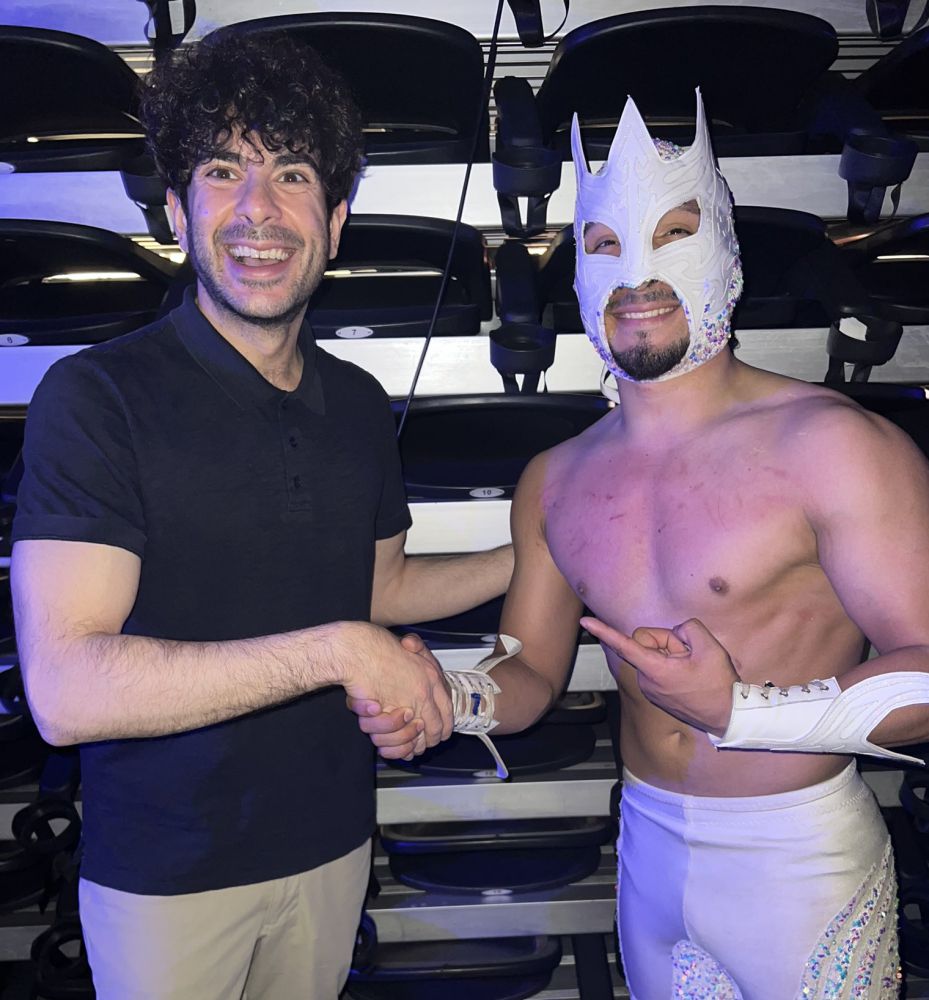
Tony Khan with Kommander at AEW in Pittsburgh on April 19, 2023. AEW Twitter photo
If I were booking — and please feel free to give Tony a call on that one — I would ditch the International title in favor of a lighter weight strap (I don’t want to use existing terms like ‘Cruiserweight’ or ‘light heavyweight’ belt since both of those titles were ultimately treated as jokes by their home promotions), where the three pillars, the guys mentioned above plus luchadores like El Hijo del Vikingo or Kommander or Dralistico would have a natural home and fan expectations would be based on workrate rather than theatrics.
I’m also mindful of demographics here: as a kid I remember the first time I saw the likes of Tiger Mask or the Blue Blazer or Leaping Lanny Poffo. These smaller, colorful, flying wrestlers were relatable and exciting to watch in a way that plodding giants like King Kong Bundy, Big John Studd or Hillbilly Jim just weren’t. AEW would do well to play to an audience that still believes in superheroes, since they have so many on the roster.
Where the concept has failed in the past is when these smaller talents are called to interact with superheavyweights on the main roster. American wrestling promotions have long decided that it’s OK to have a couple of world-beating smaller wrestlers who can beat anyone of any size like Bryan Danielson or Rey Mysterio, but when faced with even a middling muscular talent over six feet, most cruiserweights will turn into cannon fodder. AEW has bucked this trend to a point, perhaps because the average size of a US professional wrestler has decreased over the last several years… but with anchors like three of the four pillars, Hook and Danhausen why not give a lighter weight division the chance to fly?
5. FIGURE OUT WHAT TO DO WITH RING OF HONOR
It has now been over a year since Tony Khan announced his acquisition of Ring of Honor from Sinclair Broadcast Group. While Khan purchased ROH’s intellectual property and a few concrete assets, the promotion that fans knew and loved is no more.
Most importantly, Khan lost the distribution of ROH across Sinclair’s broadcast network. Without a TV outlet Khan would either have to find time for a second banner on AEW broadcasts or consign ROH to the independent wrestling paradise of streaming services, where ROH stands to be lost in the shuffle.
To his credit, Khan has snapped up a number of ROH veterans as they’ve come available directly or once their deals elsewhere have lapsed. There isn’t a ton of consistency to how they’re being used, though. Wrestlers like Dalton Castle, Shane Taylor, Rush and Silas Young feel like afterthoughts. Successful tag teams like the OGK (former champion Matt Taven and former Kanellis Mike Bennett) and the Righteous (a horror-influenced team comprised of Vincent and Dutch) lose to reconstituted WWE enhancement teams like Arya Daivari and Tony Nese. Perennial ROH all-star Jay Lethal is in a lower-midcard tag team with Jeff Jarrett. Samoa Joe is the current ROH TV champion but has been off filming movies. Christopher Daniels shows up now and again, as does Colt Cabana (often in the commentary booth). The Lucha Brothers are the current tag team champions, having won a multi-team ladder match after the untimely death of Jay Briscoe. The women’s champion is Athena, who hadn’t done much of interest before winning this title during her AEW tenure or her earlier WWE stint as Ember Moon. The ROH Six Man titles are held by the Embassy, made up of AEW original Brian Cage, Bishop Kaun and Toa Liona, the latter appear infrequently enough that I wonder whether they’re actually on the roster or just paid by appearance. Wheeler Yuta is a former Pure Champion. So is Daniel Garcia. Either brought more visibility to that belt despite being the young boys of the Blackpool Combat Club and the Jericho Appreciation Society and, respectively, than the current titlist.
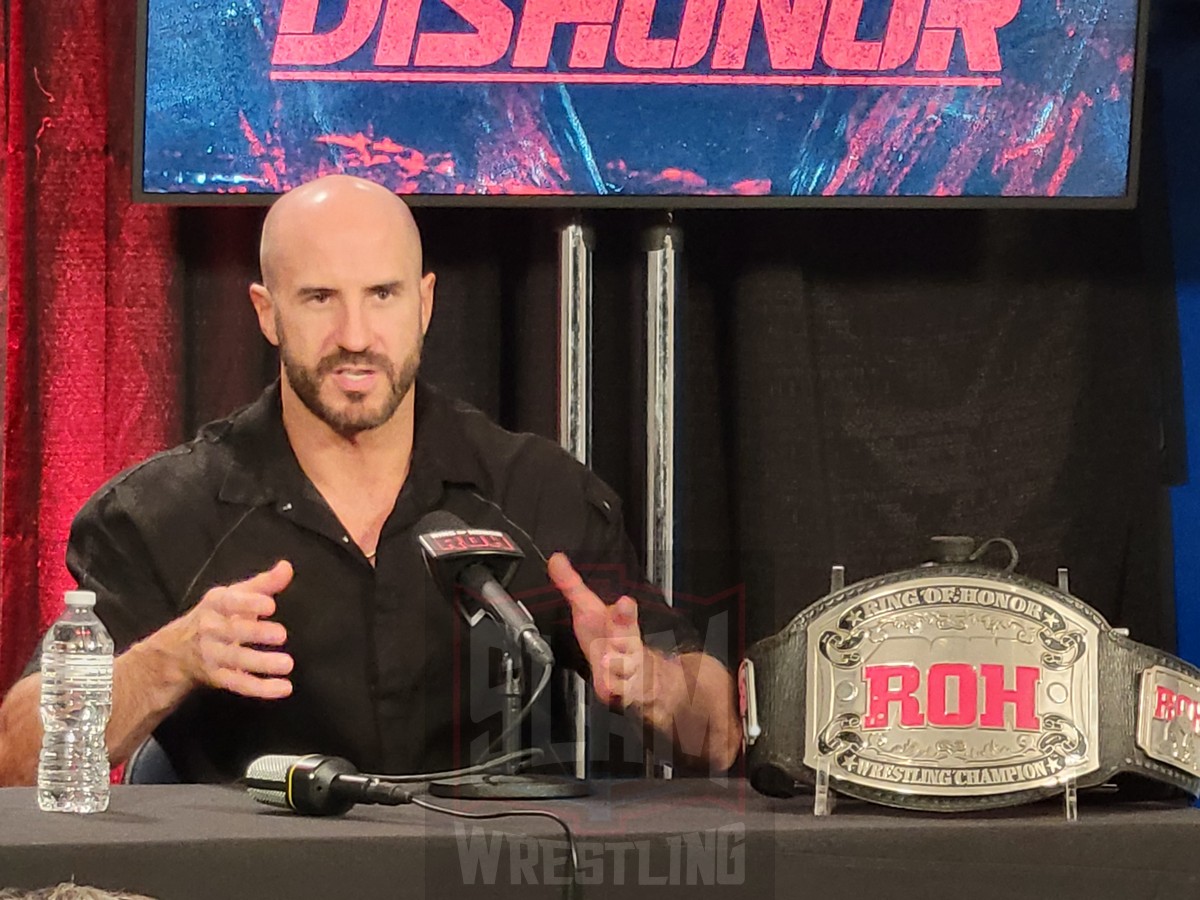
New ROH World champion Claudio Castagnoli post-show at Ring of Honor Death Before Dishonor at the Tsongas Center at UMass in Lowell, Massachusetts, on Saturday, July 23, 2022. Photo by George Tahinos, https://georgetahinos.smugmug.com
Perhaps the two biggest stars created by ROH so far have nothing to do with it. Bryan Danielson is schooling AEW stars as part of the Blackpool Combat Club, and CM Punk has been announced as a feature attraction for the first Collision episode — still under AEW’s umbrella despite the occasional disagreement with his colleagues. The rest of the ROH roster seems shared with AEW with little attempt to differentiate them. And in the absence of TV, why bother? ROH may still put on great matches, but they’re clearly second-fiddle to mainstream AEW storylines. Claudio Castagnoli is the current World Champion, and he’s most often seen on AEW playing a supporting role in the otherwise beltless BCC. I can’t imagine another stable in wrestling where a World Champion was not the focus but relegated to enforcer duty. After a few days I came up with Scott “Vicious Flapjack” Norton, who held the IGWP championship while carrying the Kliq’s bags as an nWo appendage… but Norton never rated much screen time in the US and was a draw in Japan. I’d argue that was different from Castagnoli wrestling for two promotions under the same ownership. It’s telling that the ROH title received it’s strongest solo push when Chris Jericho won it, and started a campaign where his brand of flashy ‘sports entertainment’ bested a series of former ROH champs, week after week after week. It made ROH look weak.
At the time of the sale, I wondered whether Khan just bought ROH to keep it out of WWE’s hands. After all, AEW itself was hot and in wrestling terms, still a new promotion. It was also built largely on talent procured from ROH following the first, independent All-In pay per view, and since the beginning has featured the kind of strong matches that won ROH a devoted fan base.
I questioned what Khan would do with a second promotion and to date, I still don’t have an answer. ROH has a weekly internet show and puts on occasional pay-per-views, but most of its energy seems devoted to occasional spots on Dynamite or Rampage. ROH’s weekly internet show is now slated to be taped around Collision. Hopefully a new two-hour bloc of programming will finally give ROH the platform it deserves. Maybe it’s the full hour of Rampage. Maybe it’s an hour’s worth of Collision (if you think about it, AEW and ROH ‘colliding’ kind of writes itself).
Just give the faithful something fun to watch and we’ll tune in.
RELATED LINKS
